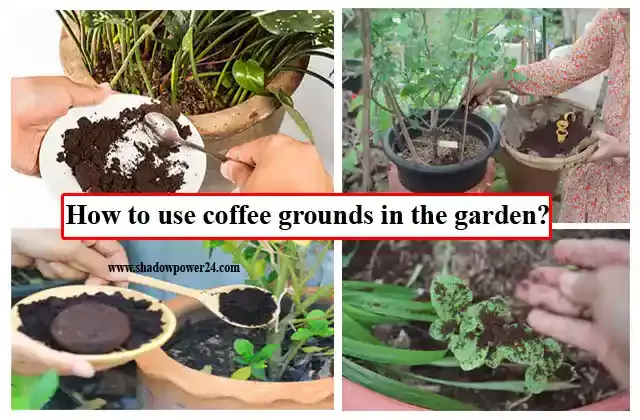How to use coffee grounds in the garden?
Coffee Grounds for the Garden: A Sustainable Powerhouse
Coffee grounds are a common household waste, but for the savvy gardener, they represent a treasure trove of potential. Packed with nutrients and boasting unique properties, used coffee grounds can be a valuable addition to your gardening repertoire. This comprehensive guide explores the many ways to utilize coffee grounds in your garden, transforming your morning cup of joe into a potent tool for a flourishing green haven.
The Perks of Coffee Grounds in the Garden
Coffee grounds offer a multitude of benefits for your garden, including:
- Nutrient Boost: Coffee grounds contain essential plant nutrients like nitrogen, phosphorus, potassium, and magnesium, all of which contribute to healthy plant growth.
- Composting Powerhouse: Coffee grounds act as a "green" material in your compost pile, accelerating the decomposition process and enriching the final compost with valuable nutrients.
- Natural Pest Repellent: The strong scent of coffee grounds is believed to deter some pests like snails, slugs, and certain insects.
- Improved Soil Drainage: Coffee grounds can help loosen compacted soil, enhancing drainage and aeration for better root development.
- Acidity Buffer (for specific plants): While the acidity of coffee grounds is a minor point of contention (more on that later), coffee grounds may provide a slight acidity boost for plants that thrive in acidic soil, like azaleas, blueberries, and hydrangeas.

Utilizing Coffee Grounds in Your Garden: Practical Methods
There are several effective ways to incorporate coffee grounds into your gardening routine:
- Composting: This is the most recommended and versatile approach. Coffee grounds are a nitrogen-rich "green" material that aids decomposition when balanced with "brown" materials like dry leaves or shredded paper in a 4:1 ratio (brown:green). Add coffee grounds in moderation (around 10-20% of your total compost volume) to avoid hindering the breakdown process.
- Direct Soil Application (with caution): Coffee grounds can be directly incorporated into the soil around established plants. However, moderation is key. Spread a thin layer (no more than ½ inch) and mix it well with the top few inches of soil. Avoid using directly around seedlings or when planting new seeds, as the grounds can hinder germination.
- Liquid Fertilizer: Soak used coffee grounds in water for a day (around 4 parts water to 1 part coffee grounds). Strain the liquid and dilute it further with water (1:10 ratio) before applying it to the base of your plants as a nutrient-rich drench.
- Mulch Magic: Coffee grounds can be mixed with other organic materials like shredded leaves or bark to create a nutrient-rich mulch. This layer helps retain moisture, suppress weeds, and gradually releases nutrients into the soil as it decomposes.
- Worm Power: Coffee grounds can be a welcome addition to your worm bin. Worms love them, and the coffee grounds help break down other food scraps in the bin, accelerating compost production.
Things to Consider When Using Coffee Grounds
Fresh vs. Used: While some gardeners recommend using fresh coffee grounds, used grounds are generally preferred. The brewing process removes some of the acidity, making them less likely to harm your plants.
Acidity: The acidity of coffee grounds is a debated topic. While they may have a slightly acidic pH when fresh, used coffee grounds are nearly neutral (around pH 6.5-7.0). Always test your soil pH before using coffee grounds and avoid using them around plants that prefer highly alkaline soil.
Moderation is Key: Too much of a good thing can be bad. Overusing coffee grounds can alter soil composition and potentially harm plants.
Frequently Asked Questions
1. Can I use coffee grounds around all plants?
Not all plants appreciate coffee grounds. Avoid using them around seedlings, newly planted seeds, or plants that prefer alkaline soil.
2. How much coffee grounds can I add to my compost pile?
Limit coffee grounds to 10-20% of your total compost volume to maintain a good balance of green and brown materials.
3. Do coffee grounds attract pests?
While the strong scent may deter some pests like snails and slugs, coffee grounds may attract fungus gnats if not composted properly. Ensure proper aeration in your compost pile.
5. How long do coffee grounds take to decompose in a compost pile?
Coffee grounds decompose relatively quickly, breaking down within a few months in a properly maintained compost pile.
6. Is there a difference between using regular and decaf coffee grounds?
There's no significant difference between the gardening benefits of regular and decaf coffee grounds. Both provide similar nutrients and properties for your plants.
7. Can I use cold brew coffee grounds in the garden?
Yes, cold brew coffee grounds can be used in your garden with the same methods as regular coffee grounds.
8. Is it okay to use flavored coffee grounds?
While non-toxic flavorings may not necessarily harm your plants, it's generally best to stick to plain coffee grounds. The artificial ingredients may disrupt the composting process or introduce unwanted chemicals to your soil.
9. Should I worry about caffeine harming my plants?
The amount of caffeine remaining in used coffee grounds is minimal and unlikely to harm your plants.
10. Where can I find free coffee grounds for my garden?
Many coffee shops offer free used coffee grounds to gardeners. Call your local shops and inquire about their policy.



